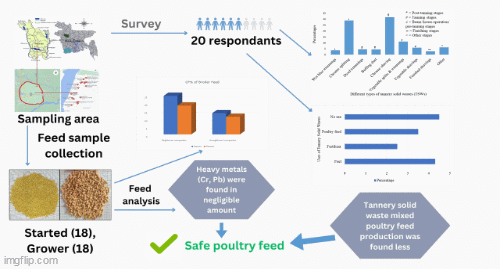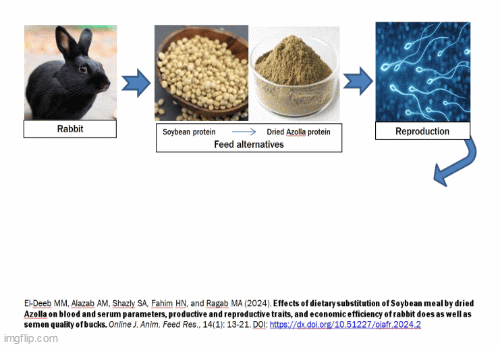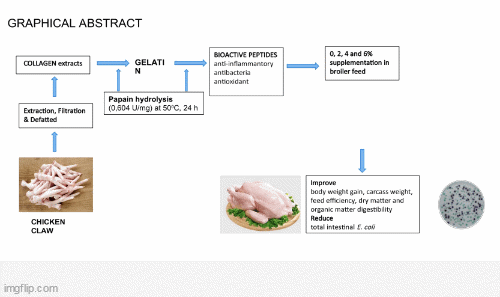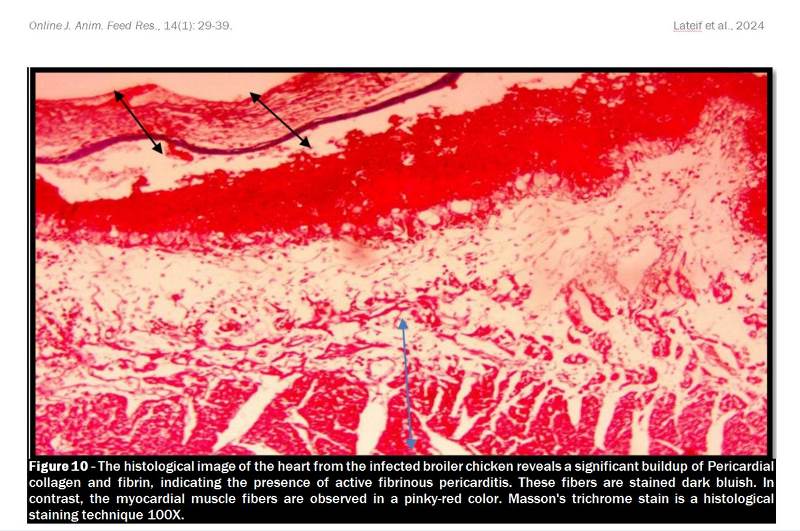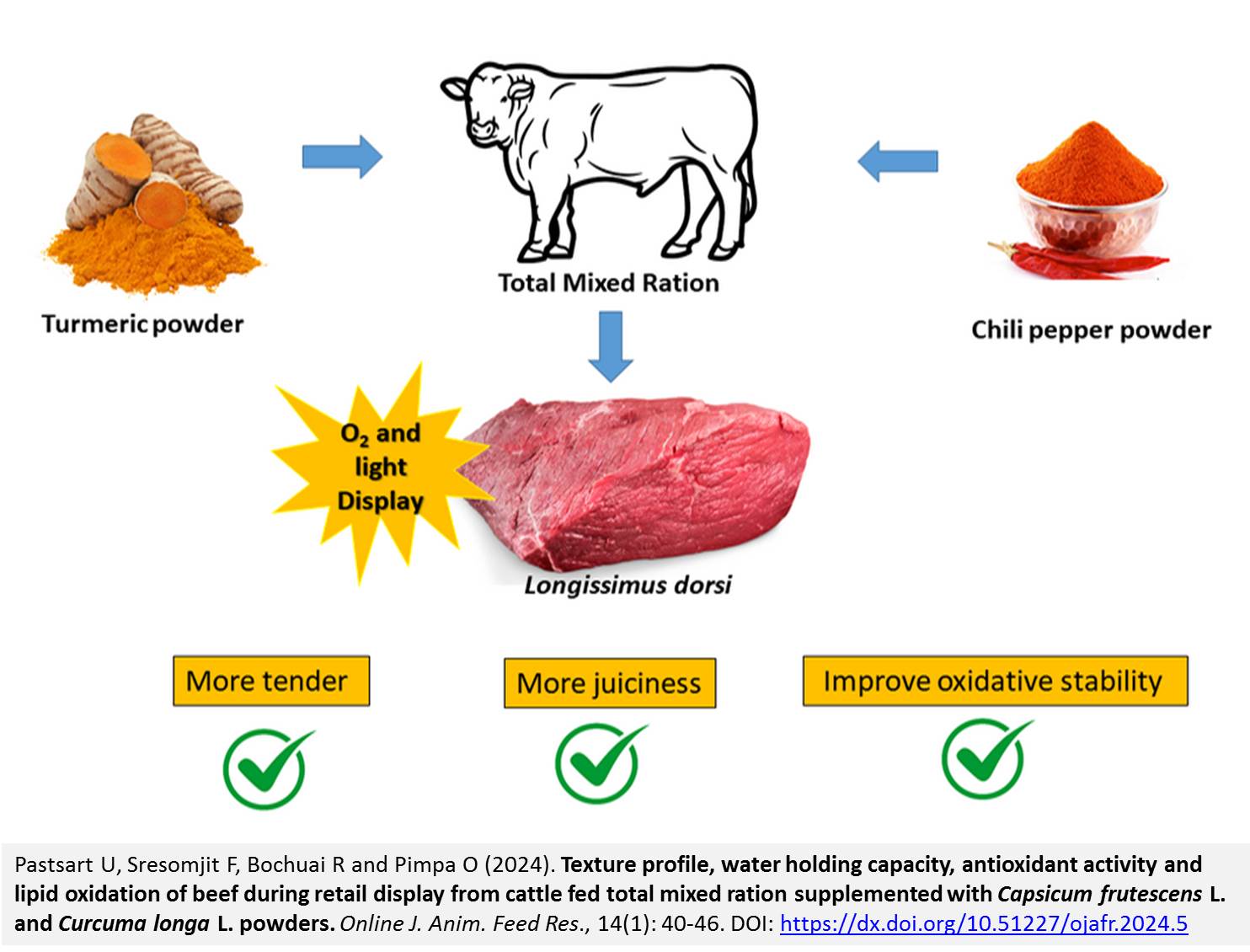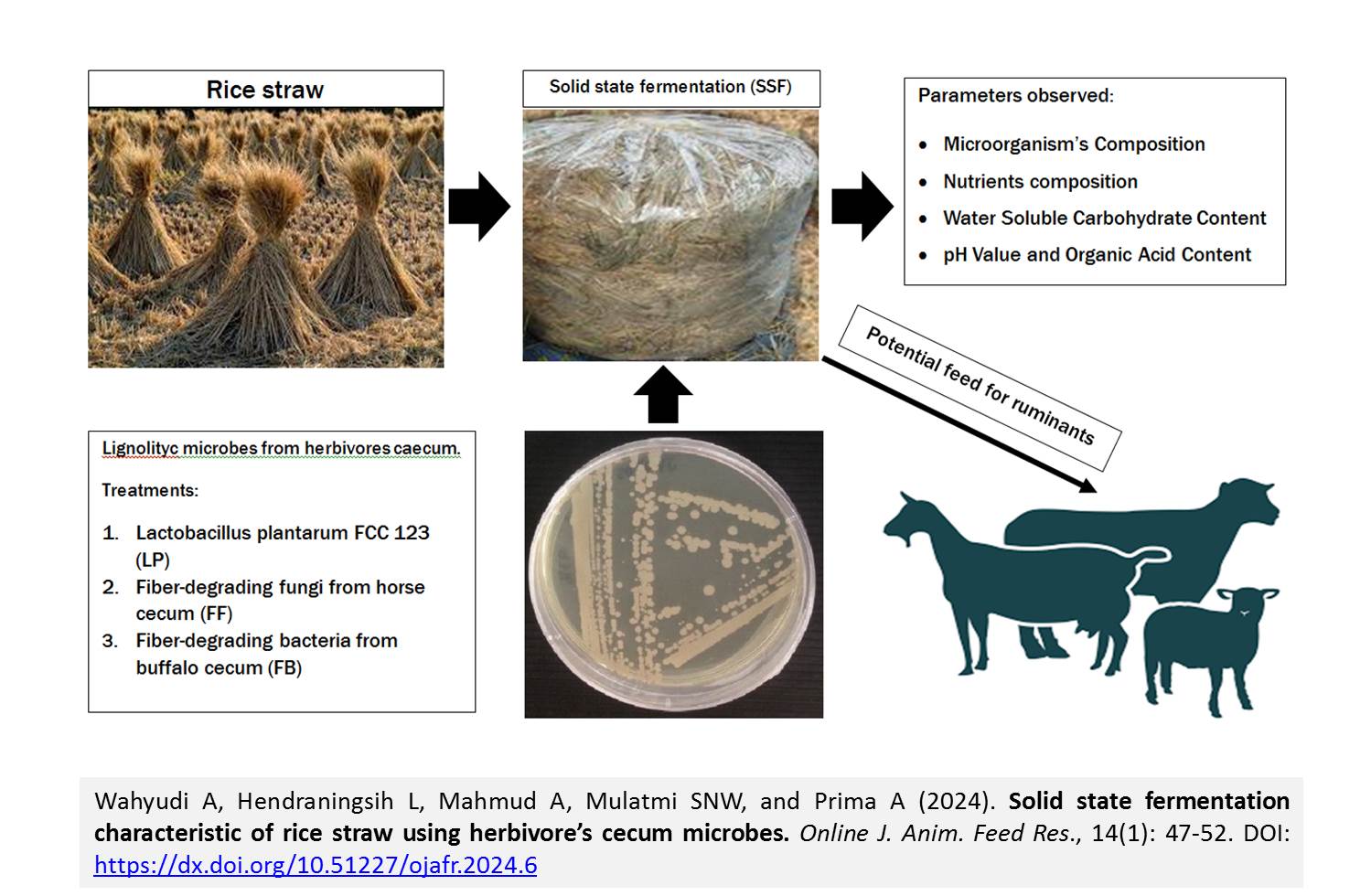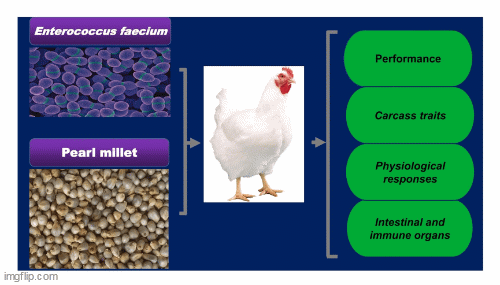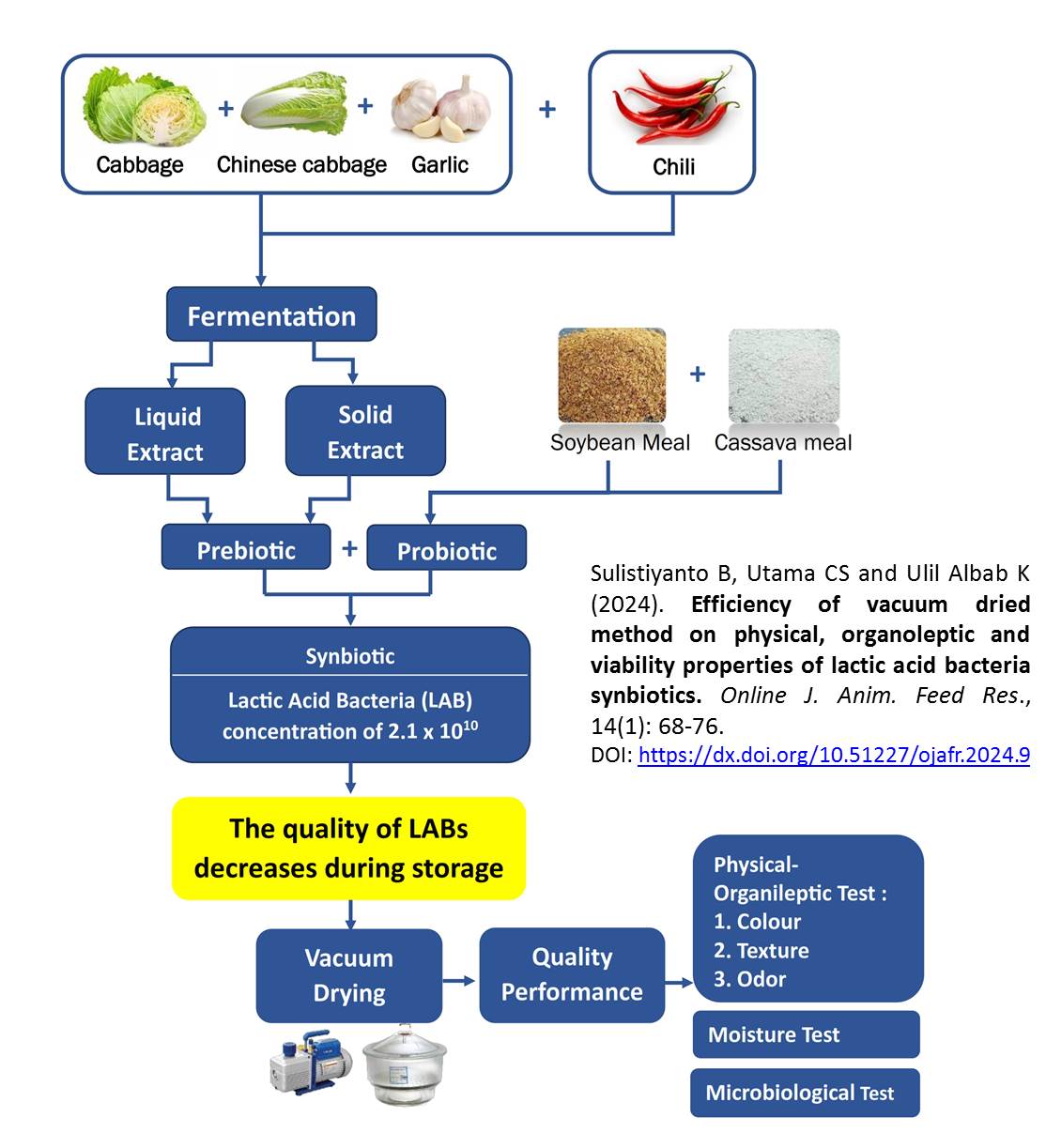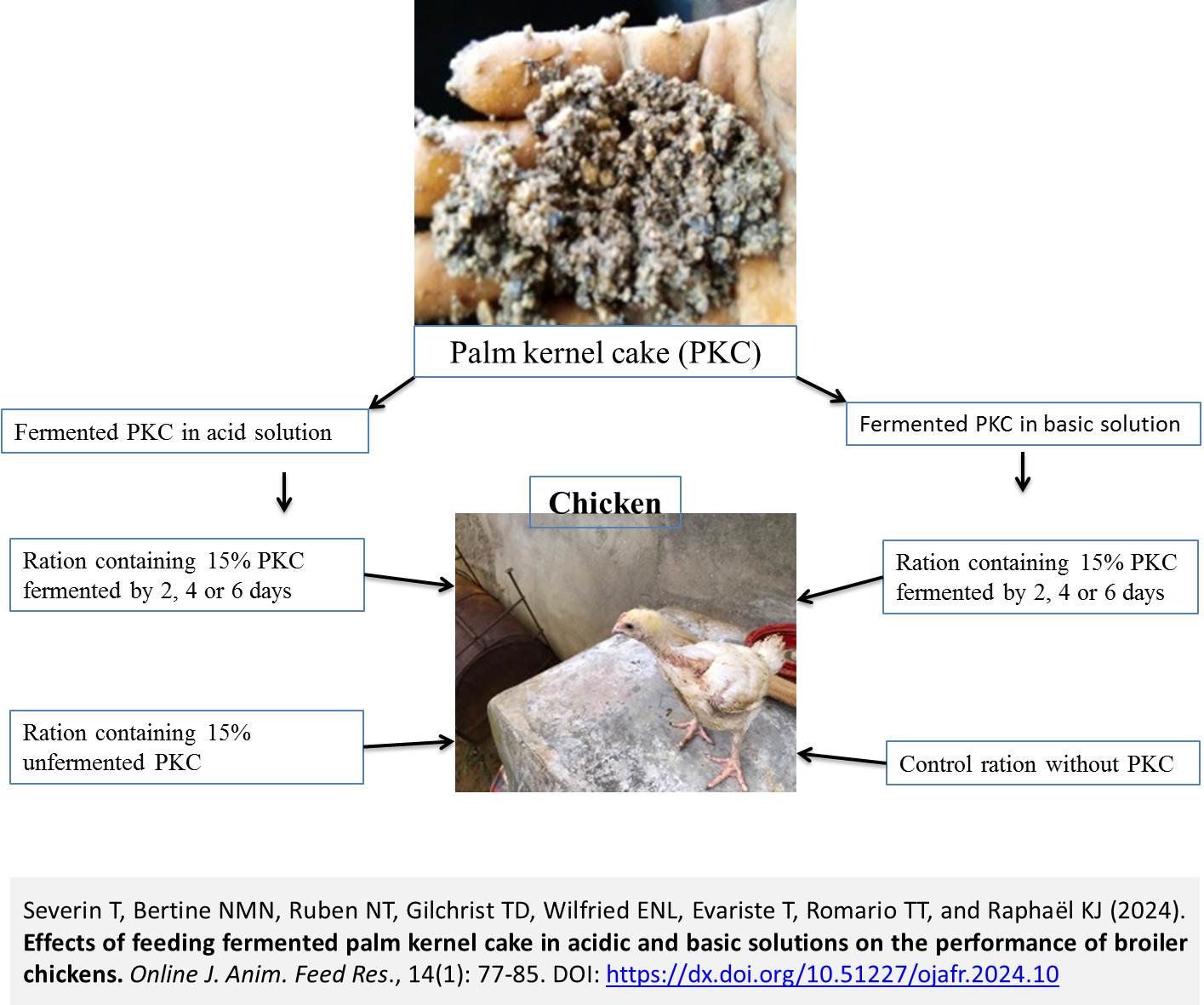Previous issue | Next issue | Archive
![]() Volume 14 (1); January 27, 2024
Volume 14 (1); January 27, 2024
Using tannery wastes in poultry feed: a matter of concern for safe poultry production in Bangladesh
Islam Md.S, Protik AS, Zannat Mst.A, Naim Z, Kabir Md.E, Asaduzzaman Md., and Akter M.
Online J. Anim. Feed Res., 14(1): 1-12, 2024; pii: S222877012400001-14
DOI: https://dx.doi.org/10.51227/ojafr.2024.1
Abstract
Nowadays tannery waste is a matter of concern because if it used as livestock feed, it could cause health hazards to humans. Therefore, this study was conducted to know the generation rates, utilization, disposal method of tannery solid wastes (TSWs), and inclusion level of it into the poultry feed. Moreover, this study determined the physical and chemical parameters of interest including moisture content, crude protein (CP) levels, and the presence of heavy metals such as chromium (Cr) and lead (Pb) in the poultry feeds that were sold in the studied area. For these purposes, a field survey was conducted with twenty tannery industries. Broiler feed samples were procured from multiple farmers situated in the Savar area of Dhaka. The feed source was classified into two categories, namely registered and unregistered feed mills. According to the study, wet blue trimmings was generated in 3.84% that was used as an ingredient of poultry feed. In addition, 55% of tanneries landfilled their waste, while 30% of them sold it for poultry feed. The utilization of TSWs in poultry feed production in this country was limited to a maximum of 1.314% of the total annual production. Besides, the CP% was determined in the range of 24.24 - 13.32 % and 18.15 - 11.01 % for broiler starters and growers, respectively, where lower CP content was found only in unregistered feed mills. Trace amounts of Cr and Pb were identified in each of the feed samples at very low concentrations. In conclusion, it can be stated that the percentage of tannery solid wastes mixed poultry feed was generated in negligible amounts and the registered companies’ feed was found normal in all aspects of the quality tested in the study.
Keywords: Broiler feed, Feed mill, Heavy metal, Physical quality, Tannery solid waste
[Full text-PDF] [Scopus] [ePub] [Export from ePrints]
Effects of dietary substitution of Soybean meal by dried Azolla on blood and serum parameters, productive and reproductive traits, and economic efficiency of rabbit does as well as semen quality of bucks
El-Deeb MM, Alazab AM, Shazly SA, Fahim HN, and Ragab MA.
Online J. Anim. Feed Res., 14(1): 13-21, 2024; pii: S222877012400002-14
DOI: https://dx.doi.org/10.51227/ojafr.2024.2
Abstract
An experiment was carried out to investigate the effects of dietary substitution of dried Azolla (Azolla pinnata) in different ratios by soybean meal on productive and reproductive performances, hematological and serum traits, and economic efficiency of rabbit does as well as semen quality of males. Forty mature does and eight males of Black Balady rabbits aged seven and eight months were assigned to 1 of 4 dietary groups: 0 (control), 20, 30, and 40% of soybean protein substituted with dried Azolla protein. Data were analyzed using repeated measures of statistical software computer program package. There were no significant differences among groups in number of services per conception as well as parturition intervals (days) with a superiority of 30% group over the control and other two groups. Average litter weight was significantly (P<0.05) superior in the 30% replacement group. There were no significant differences in live body weight either at birth or at weaning among the four tested groups and the 30% replacement groups recorded the highest significant daily weight gain of bunnies during the whole experimental period. All Azolla groups recorded better results in the studied traits of bucks' semen compared to the control. Azolla diets did not show any adverse effects on the studied blood parameters. The 30% replacement of the soybean protein group showed the best economic return compared to the other two replacement groups and the control. In conclusion, Azolla can safely and economically replace soybean protein at the rate of 30% in adult female rabbits' diets.
Keywords: Azolla, Body weight, Rabbit, Reproduction, Semen.
[Full text-PDF] [Scopus] [ePub] [Export from ePrints]
Performance, carcass weight, total intestinal bacteria, and feed digestibility of broilers fed chicken foot-derived bioactive peptides
Rahayu S, Suhartati FM, Hartoyo B, Bata M, Widiyastuti T, Rimbawanto EA, Hidayat N, and Prihambodo TR.
Online J. Anim. Feed Res., 14(1): 22-28, 2024; pii: S222877012400003-14
DOI: https://dx.doi.org/10.51227/ojafr.2024.3
Abstract
The aim of this study was to evaluate the supplementation of chicken claw-derived bioactive peptides on performance, carcass weight, total intestinal bacteria, and feed dry matter (DMD) and organic matter (OMD) digestibility of broilers. A completely randomized design and five repetitions were applied in this experiment. The research material consisted of 200 DOC strain CP-707 grown up to 35 days of age, and the biopeptide was produced by hydrolyzing chicken claws protein with a commercial papain enzyme. Bioactive peptides were added to feed treatments in amounts of 0, 2, 4, and 6%. The differences between treatments were tested using the honestly significant difference test. The addition of chicken claws biopeptides had a significant influence (P<0.01) on OMD and carcass weight, as well as a significant effect (P<0.05) on body weight gain, feed efficiency, DMD and total bacteria. Addition of chicken claws-derived peptides in rations up to 6% enhanced body weight gain, feed efficiency, carcass weight, DMD, OMD, and total intestinal bacteria in broiler chickens.
Keywords: Biopeptides, Chicken, Claw, Digestibility, Carcass quality.
[Full text-PDF] [Scopus] [ePub] [Export from ePrints]
Genotypic characterization of Escherichia coli isolated from infected chicken in Basrah, Iraq
Lateif BM, Ahmed JA, Najem HA.
Online J. Anim. Feed Res., 14(1): 29-39, 2024; pii: S222877012400004-14
DOI: https://dx.doi.org/10.51227/ojafr.2024.4
Abstract
This study aimed to detect the presence of Escherichia coli in broiler and layer hens in the Basrah province, Iraq using macroscopic and microscopic diagnosis and bacterial isolation that causes infection insome internal organs (liver and heart), and by polymerase chain reaction. Randomly chosen samples were taken from different places within Basrah province for further investigation (poultry fields in Al-Qurnah and Al-Hartha). The bacteriological analysis revealed that the presence of Escherichia coli is responsible for causing fibrinous pericarditis and perihepatitis in birds. The macroscopic examination revealed hemorrhagic lesions and a significant buildup consisting of a white fibrous accumulation in the pericardial sac of the infected birds' hearts. The livers of infected birds exhibited significant deposition of white fibrous exudate on the liver surface, along with hepatomegaly. The afflicted heart displays a microscopic appearance marked by a notable aggregation of inflammatory cells in the pericardial sac and the release of fibrinous exudate. Additionally, there is an accumulation of edematous exudate in the cardiac muscle fibers, accompanied with congestion of blood vessels in the myocardium. The microscopic examination of the infected liver revealed the existence of a significant infiltration of inflammatory cells in the liver capsule, as well as the presence of a thick fibrinous exudate encapsulated on the liver surface and congestion of the central vein. The histological analysis of the affected heart and liver revealed a significant buildup of collagen and fibrin fibers, which exhibit a prominent dark bluish staining. This buildup is widely distinguished in the pericardial and hepatic capsules. The study indicated that fibrinous pericarditis and perihepatitis affected birds, as indicated by the examination of bacterial results. Escherichia coli emits endotoxins that induce vascular damage in the heart and liver, resulting in an elevated presence of fibrin exudate around the affected tissue. The histological analysis supported this conclusion.
Keywords: Fibrinous, Pericarditis, Perihepatitis, Pathology, Biological.
[Full text-PDF] [Scopus] [ePub] [Export from ePrints]
Texture profile, water holding capacity, antioxidant activity and lipid oxidation of beef during retail display from cattle fed total mixed ration supplemented with Capsicum frutescens L. and Curcuma longa L. powders
Pastsart U, Sresomjit F, Bochuai R and Pimpa O.
Online J. Anim. Feed Res., 14(1): 40-46, 2024; pii: S222877012400005-14
DOI: https://dx.doi.org/10.51227/ojafr.2024.5
Abstract
This study aimed to elucidate the effects of supplementation of Capsicum frutescens L. or chili pepper (ChP) and Curcuma longa L. or turmeric (T) powders combination in total mixed ration (TMR) on texture profile, water holding capacity (WHC) and oxidative stability of beef during days 0, 5 and 10 of retail display. The experiment was carried out on 16 crossbred bulls (Brahman and Charolais) of about 2 years in age. The bulls were randomly assigned to 4 dietary treatment groups as follows: 1) TMR as control, 2) TMR + 1%ChP powder, 3) TMR + 1%T powder, and 4) TMR supplemented with a mixed powder of 1%ChP + 1%T, over a 6 months feeding period. The results revealed that the hardness and gumminess of control beef were higher than other groups, and the cohesiveness of beef from cattle fed a mixed powder of 1%ChP + 1%T was lower than other groups (P<0.05). Regarding WHC, the results showed that, on days 0 and 5 of storage, the control group meat had higher cooking losses than either the 1%T or a mixture of 1%ChP + 1%T groups (P<0.05). Also, on 0 and 5 days of retail display, the 1%ChP + 1%T group showed the highest antioxidant activity when compared to other groups (P<0.05). As for the lipid oxidation in beef, on day 5 of storage MDA level in control beef was higher than the 1%T or a mixture of 1%ChP + 1%T groups (P<0.05). It can be concluded that the combination of chili pepper and turmeric powder in TMR can improve texture, water holding capacity, and oxidative stability of beef during refrigerated storage.
Keywords: Beef, Chili pepper, Cooking loss, Oxidative stability, Texture profile, Turmeric powder.
[Full text-PDF] [Scopus] [ePub] [Export from ePrints]
Solid state fermentation characteristic of rice straw using herbivore’s cecum microbes
Wahyudi A, Hendraningsih L, Mahmud A, Mulatmi SNW, and Prima A.
Online J. Anim. Feed Res., 14(1): 47-52, 2024; pii: S222877012400006-14
DOI: https://dx.doi.org/10.51227/ojafr.2024.6
Abstract
This study was aimed at identifying highly capable lignolytic microbes from nature for use in Solid State Fermentation (SSF) of rice straw. The SSF silage was prepared in laboratory scale, as the following treatments: uninoculated (control), Lactobacillus plantarum FCC 123 (LP), fiber-degrading fungi (Aspergillus sp.) from horse cecum (FF), and fiber-degrading bacteria (Enterococcus casseliflavus) from buffalo cecum (FB). Incubation was carried out for a month at room temperature. The observed parameters were: organic acids, water-soluble carbohydrate (WSC), microorganism and nutrient composition. Rice straw SSF that was inoculated with LP showed the highest quality of fermentation, indicated by significant highest lactic acid bacteria (LAB) population, and has the lowest of poor bacteria indicators (coliform, aerobic bacteria, and bacilli). The LP treatment also has the highest LAB content and lowest WSC. Among treatments, FB treatment seems to have given a similar result with LP followed by FF. While the chemical composition seems unaffected by treatments. Compared with the fresh material, all fermentation with and without inoculants has reduced neutral detergent fiber (NDF) and increased acid detergent fiber (ADF), but there were no differences among all treatments. Inoculation of both LP and FB could improve rice straw SSF silage quality, but this system could not improve fiber degradation as well as in liquid state fermentation (LSF).
Keywords: Microorganism, Organic acid, Silage, Straw, Water soluble carbohydrate
[Full text-PDF] [Scopus] [ePub] [Export from ePrints]
Effects of probiotic Enterococcus faecium and raw, fermented and sprouted pearl millet based diets on performances, carcass traits, hematological and biochemical indices of broiler chickens
Olasehinde O and Aderemi F.
Online J. Anim. Feed Res., 14(1): 53-60, 2024; pii: S222877012400007-14
DOI: https://dx.doi.org/10.51227/ojafr.2024.7
Abstract
Probiotics, recognized as a safe substitute for antibiotics in the animal industry, have been acknowledged for their growth-enhancing properties. This study assessed the impact of Enterococcus faecium strain NCIMB 11181 and diets incorporating Raw, Sprouted, and Fermented pearl millet on the performance, carcass traits, organ weights, and blood parameters of broiler chickens. In a randomized design, 120 one-day-old Arbor Acre broiler chickens were assigned to five groups: 1) No supplement, negative control (N-con); 2) Control + antibiotics, positive control (P-con); 3) Raw pearl millet + probiotics in drinking water (RPM + PRO); 4) Sprouted pearl millet + probiotics in drinking water (SPM+PRO); 5) Fermented pearl millet + probiotics in drinking water (FPM + PRO). Probiotic supplementation did not significantly impact body weight gain (BWG) but influenced feed intake (FI) (P<0.05). FPM+PRO increased feed conversion ratio (FCR), thigh yield, and drumstick yield. Thymus weight is reduced in the RPM+PRO and SPM+PRO groups compared to the control groups. Serum high-density lipoprotein (HDL) levels decreased (P<0.01) in the P-con and FPM+PRO groups. No treatment effect (P>0.05) was observed on hematological indices. Overall, pearl millet diets supplemented with probiotics demonstrated no adverse effects on the health status of broiler chickens, suggesting their potential as viable alternatives to antibiotics.
Keywords: Pearl millet, Broiler chickens, Blood, Carcass traits, Growth performance, Probiotics.
[Full text-PDF] [Scopus] [ePub] [Export from ePrints]
Processing of slaughterhouse blood for antianemic food products
Omarov R and Shlykov S.
Online J. Anim. Feed Res., 14(1): 61-67, 2024; pii: S222877012400008-14
DOI: https://dx.doi.org/10.51227/ojafr.2024.8
Abstract
Currently, rational processing of blood from slaughterhouses remains as a waste fluid in many regions. Traditional approaches to use the blood for food are significantly limited because of specific and non-favorable organoleptic characteristics. Present study provides a comparison of various methods for modifying the red blood cell (RBC) mass of animals and a more in-depth study of acid hemolysis. The solution of ascorbic acid has been proposed as a hemolyzing agent. There has been established experimentally that the addition of equal volumes of RBC and a solution of an ascorbic acid with a concentration of 0.75 mol/dm3 can effectively destroy the stroma more up 90% of red blood cells within 15 minutes. By this, the hemoglobin oxidation degree to methemoglobin is about 50%, which forms the desired color of the resulting hydrolysate. The dry semi-finished product has a neutral odor and brown color with high functional and technological properties. It also contains 0.9% organic iron with good biological value. Thus, the study shows that blood products can effectively use in various foods such as meat products, and also as a dietary supplement for various proposes. Consumption of these products has potent positive effect on hemoglobin levels and it is recommending for people with iron deficiency anemia.
Keywords: Antianemia products, By‐products, Heme iron, Farm animals, Slaughterhouse.
[Full text-PDF] [Scopus] [ePub] [Export from ePrints]
Efficiency of vacuum dried method on physical, organoleptic and viability properties of lactic acid bacteria synbiotics
Sulistiyanto B, Utama CS and Ulil Albab K.
Online J. Anim. Feed Res., 14(1): 68-76, 2024; pii: S222877012400009-14
DOI: https://dx.doi.org/10.51227/ojafr.2024.9
Abstract
Vacuum drying storage is a more efficient storage method for synbiotic feeds, compared to fresh storage. The current study aimed to examine the effect of vacuum drying on the physical, organoleptic, and microbiological qualities of synbiotics made from cabbage and Chinese cabbage greens. The study was conducted using a completely randomized design with a 5x3 factorial pattern with two replications consisting of two factors, namely five levels of drying time (24, 48, 72, 96, and 120 hours) and three levels of storage time (4, 8 and 16 weeks). The variables observed were physical-organoleptic quality in water content, color, odor, and texture, and microbiological quality in the form of total lactic acid bacteria. The results showed no interaction between the two treatments in terms of vacuum drying method, drying time, and storage time. The recommended treatment is drying for 48 hours, as evidenced by the moisture content factor supporting the viability of the lactic acid bacteria and maintaining the sensory properties. This study suggests a more efficient storage method of synbiotics for food applications.
Keywords: Lactic Acid Bacteria, Orgoleptic, Storage, Synbiotic, Vacuum Drying.
[Full text-PDF] [Scopus] [ePub] [Export from ePrints]
Effects of fermented palm kernel cake in acidic and basic solutions on the performance of broiler chickens
Teufack S, Noumbissi MNB, Ngouana TR, Tchouan DG, Edie NLW, Taboumda E, Tindo TR, and Kana JR.
Online J. Anim. Feed Res., 14(1): 77-85, 2024; pii: S222877012400010-14
DOI: https://dx.doi.org/10.51227/ojafr.2024.10
Abstract
Palm kernel meal is a by-product used very sparingly in poultry feed, due to its low nutritional value and gravelly appearance which could be improved by physical or chemical treatments. The aim of this study was to assess the effect of palm-kernel meal fermentation period on its nutritional value and growth performances of broiler chickens. The treatment consisted of fermenting palm kernel meal in a solution of humic acid (HA) or limestone, for 0, 2, 4 and 6 days. A control ration without palm kernel meal (R0) was compared rations containing 15% unfermented palm kernel cake (R0+) and 15% fermented palm kernel cake in humic acid and limestone solutions. Each experimental ration was randomly assigned to 8 chicks in 4 experimental units of 02 chicks each, repeated 4 times per a 2×3 factorial design (2 fermentation modes and 3 fermentation period). The main results showed that fat content (13.04%) and metabolizable energy (5314 Kcal/kg DM) of palm kernel meal were higher when fermented in humic acid for 6 days. Fermentation in the basic solution for the same period (6 days) increased protein (13.52%) and cellulose (24.21%) contents. Whatever the fermentation mode, the digestive utilization coefficient of dry matter, organic matter, crude protein and crude cellulose increased with the fermentation period. Fermentation mode and period had no significant effect on growth performance. However, growth characteristics tended to improve with fermentation period. In conclusion, fermentation of palm kernel in humic acid and limestone solutions improved significantly (P<0.05) the digestibility of all feed components, enabling chickens to take advantage of the nutrients for better growth performances.
Keywords: Chemical composition, Digestibility, Fermentation, Humic acid, Metabolizable energy, Palm kernel meal.
[Full text-PDF] [Scopus] [ePub] [Export from ePrints]
Previous issue | Next issue | Archive
This work is licensed under a Creative Commons Attribution 4.0 International License (CC BY 4.0).![]()
| < Prev | Next > |
|---|

